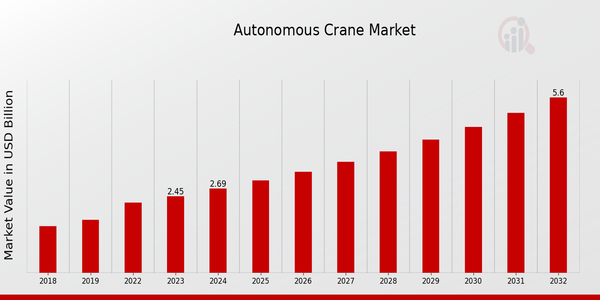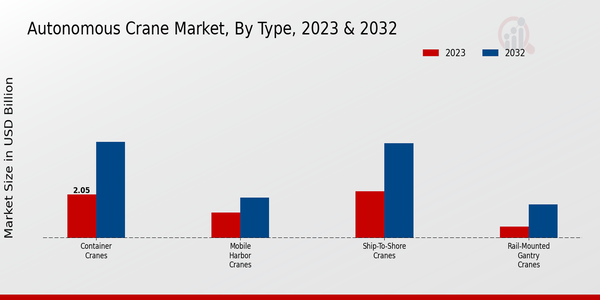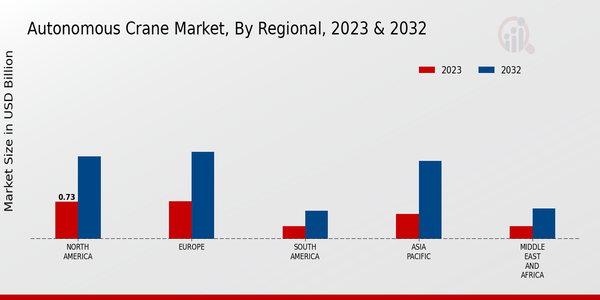Autonomous Crane Market Overview:
As per MRFR analysis, the autonomous crane market size was estimated at 2.24 (USD Billion) in 2022. The autonomous crane market industry is expected to grow from 2.45(USD Billion) in 2023 to 5.6 (USD Billion) by 2032. The autonomous crane market CAGR (growth rate) is expected to be around 9.6% during the forecast period (2024-2032).
Key Autonomous Crane Market Trends Highlighted
The global market for autonomous cranes is experiencing a surge in adoption driven by key market drivers such as the rising demand for increased efficiency, reduced labor costs, and enhanced safety in hazardous environments. The construction and logistics sectors are major end-users, leveraging autonomous cranes for tasks like lifting heavy loads, automated load handling, and remote operations. Opportunities abound for players in this market, including developing advanced technologies for improved navigation, obstacle detection, and remote monitoring capabilities.
Recent trends in the autonomous crane market include the integration of AI and ML algorithms for enhanced decision-making, increased autonomy levels through advanced sensors and actuators, and the rise of cloud-based platforms for remote management and data analysis. These advancements are paving the way for more sophisticated and efficient autonomous crane systems that can operate seamlessly in complex and dynamic environments.

Source: Primary Research, Secondary Research, MRFR Database and Analyst Review
Autonomous Crane Market Drivers
Accelerating Adoption of Automation in Construction
The Autonomous Crane Market is primarily driven by the increasing adoption of automation in the construction industry. The construction sector is witnessing a significant shift towards mechanized and automated processes to enhance productivity, efficiency, and safety. Autonomous cranes offer numerous advantages over traditional cranes, such as improved accuracy, reduced labor costs, and enhanced safety features. These factors are contributing to the rising demand for autonomous cranes in the global construction industry.The integration of advanced technologies, such as artificial intelligence (AI) and machine learning (ML), is revolutionizing the capabilities of autonomous cranes.
These technologies enable cranes to perform complex tasks with greater precision and efficiency. For instance, AI-powered cranes can analyze data from sensors and cameras to optimize their movements and avoid collisions. ML algorithms can be used to train cranes to adapt to changing job site conditions, reducing the need for human intervention.Furthermore, the growing emphasis on sustainability in the construction industry is driving the adoption of autonomous cranes.
Autonomous cranes can be equipped with energy-efficient features, such as hybrid power systems and regenerative braking, which reduce fuel consumption and emissions. The use of autonomous cranes can contribute to the reduction of the construction industry's environmental impact, supporting the transition towards more sustainable building practices.
Growing Demand for Infrastructure Development
The expanding global population and rapid urbanization are driving the need for infrastructure development worldwide. Governments and private organizations are investing heavily in infrastructure projects, such as roads, bridges, and buildings, to support economic growth and improve the quality of life. Autonomous cranes play a crucial role in these projects by enabling faster and more efficient construction processes.The ability of autonomous cranes to operate 24/7 without the need for human operators allows for continuous construction activity, reducing project timelines and costs.
Moreover, the precision and accuracy of autonomous cranes ensure that structures are built to exacting standards, enhancing their durability and safety.The Autonomous Crane Market is witnessing a surge in demand from developing countries, where infrastructure development is a key priority. These countries are investing in autonomous cranes to accelerate the construction of essential infrastructure, such as power plants, transportation networks, and communication systems.
Advancements in Sensor and Control Technologies
The Autonomous Crane Market is being driven by the continuous advancements in sensor and control technologies. These advancements have significantly enhanced the capabilities and performance of autonomous cranes.Modern autonomous cranes are equipped with an array of sensors, such as lidar, radar, and ultrasonic sensors, which provide real-time data about the surrounding environment. This data is processed by advanced control algorithms to enable precise and safe crane operation.The integration of these technologies has led to significant improvements in the safety of autonomous crane operations.
Autonomous cranes can detect and avoid obstacles, reducing the risk of accidents and injuries on construction sites. Additionally, these technologies enable autonomous cranes to operate in challenging and hazardous environments, such as extreme weather conditions or confined spaces.
Autonomous Crane Market Segment Insights:
Autonomous Crane Market Type Insights
The Autonomous Crane Market is segmented by Type into Container Cranes, Ship-to-Shore Cranes, Rail-Mounted Gantry Cranes, Mobile Harbor Cranes, and Others. The Container Cranes segment accounted for the largest share of the market in 2023, and is expected to continue to dominate the market during the forecast period. The growth of this segment can be attributed to the increasing demand for container handling in ports and terminals around the world. The Ship-to-Shore Cranes segment is also expected to witness significant growth during the forecast period, due to the increasing number of container ships and the need for efficient cargo handling.
The Rail-Mounted Gantry Cranes segment is expected to grow at a steady pace during the forecast period, due to the increasing use of these cranes in rail yards and intermodal terminals. The Mobile Harbor Cranes segment is also expected to witness moderate growth during the forecast period, due to the increasing demand for these cranes in ports and terminals where space is constrained. The Others segment includes a variety of other types of autonomous cranes, such as straddle carriers and automated stacking cranes. The growth of the market can be attributed to the increasing demand for automation in ports and terminals, as well as the increasing adoption of Industry 4.0 technologies.
The market is also expected to benefit from the increasing investment in infrastructure projects around the world.

Source: Primary Research, Secondary Research, MRFR Database and Analyst Review
Autonomous Crane Market Application Insights
The Autonomous Crane Market is segmented by application into Port Operations, Shipyard Operations, Construction, Mining, and Automotive. Among these segments, Port Operations is expected to hold the largest market share in 2023, accounting for over 35% of the Autonomous Crane Market revenue. The growth of this segment can be attributed to the increasing adoption of autonomous cranes in port terminals to improve efficiency and safety. Shipyard Operations is another significant segment, with a market share of over 25%. The demand for autonomous cranes in shipyards is driven by the need to automate complex and hazardous tasks, such as lifting and transporting heavy loads.
Construction, Mining, and Automotive are other important segments, with growing demand for autonomous cranes due to their ability to improve productivity and reduce costs.
Autonomous Crane Market Level of Automation Insights
The Autonomous Crane Market is segmented into different levels of automation, including semi-autonomous and fully autonomous. The semi-autonomous segment held a dominant market share in 2023, owing to its cost-effectiveness and flexibility. It allows for human operators to maintain a degree of control over the crane's operation while automating certain tasks, such as load handling and positioning. However, the fully autonomous segment is projected to exhibit a higher growth rate during the forecast period, driven by advancements in technology and increasing demand for efficient and labor-saving solutions.
Autonomous Crane Market Power Source Insights
The Autonomous Crane Market Segmentation by Power Source offers a comprehensive analysis of the market, taking into account various factors that influence its growth trajectory. The market is segmented into three primary categories: Electric, Diesel-Electric, and Hybrid. Electric: The electric segment held the dominant share in the Autonomous Crane Market in 2023 and is projected to maintain its lead throughout the forecast period. Electric cranes are gaining traction due to their eco-friendly nature, low operating costs, and reduced noise pollution.
The rising demand for sustainable solutions in the construction industry is driving the adoption of electric cranes. Diesel-Electric: Diesel-electric cranes accounted for a significant portion of the Autonomous Crane Market revenue in 2023 and are expected to continue to play a crucial role in the market. These cranes combine the power of a diesel engine with the efficiency of an electric motor, offering high performance and fuel economy. They are particularly suitable for heavy-duty applications and remote locations with limited access to electricity.
Hybrid: The hybrid segment of the Autonomous Crane Market is anticipated to witness notable growth in the coming years. Hybrid cranes seamlessly integrate both diesel and electric power sources, allowing for optimal fuel efficiency and reduced emissions. They offer the flexibility to operate in both electric-only and hybrid modes, catering to diverse application requirements. The increasing adoption of hybrid technology in the construction industry is expected to drive the demand for hybrid cranes. The Autonomous Crane Market segmentation by Power Source provides valuable insights into the industry's dynamics and helps identify growth opportunities for stakeholders.
Each segment exhibits unique characteristics, addressing specific customer needs and preferences. Understanding the market segmentation and its implications enables businesses to develop targeted strategies, optimize product offerings, and gain a competitive edge in the Autonomous Crane Market.
Autonomous Crane Market Payload Capacity Insights
The payload capacity segment plays a pivotal role in shaping the Autonomous Crane Market's landscape. Cranes with payload capacities less than 50 tons accounted for a significant market revenue share in 2023. These cranes are commonly used in construction, manufacturing, and logistics industries for lighter lifting tasks.
The 50-100 tons payload capacity segment is projected to witness substantial growth, driven by increasing demand from infrastructure development and wind energy sectors. Cranes with capacities ranging from 100-200 tons cater to heavy-duty applications in industries such as mining, shipbuilding, and offshore construction. This segment is expected to contribute a substantial share to the overall market growth.
Cranes with payload capacities exceeding 200 tons are specialized equipment used for exceptional lifting requirements in industries like nuclear power plants and bridge construction. The demand for these cranes is anticipated to increase in the coming years, owing to the growing need for efficient and safe handling of massive components.
Autonomous Crane Market Regional Insights
The Autonomous Crane Market revenue was valued at 2.45 USD Billion in 2023, and it is expected to reach 5.6 USD Billion by the year 2032, exhibiting a CAGR of 9.6% during the forecast period. Region-wise, the market is segmented into North America, Europe, APAC, South America, and MEA.
North America is expected to hold a significant market share in 2023, owing to the increasing adoption of autonomous cranes in various industries such as construction, manufacturing, and logistics. Europe is also expected to witness substantial growth in the autonomous crane market due to the increasing demand for efficient and cost-effective material handling solutions. APAC is anticipated to be the fastest-growing region in the autonomous crane market due to the rapid industrialization and infrastructure development in countries like China and India.

Source: Primary Research, Secondary Research, MRFR Database and Analyst Review
Autonomous Crane Market Key Players and Competitive Insights:
Major players in the autonomous crane market strive to maintain a competitive edge through innovative product development, strategic partnerships, and a focus on customer satisfaction. Leading market players invest in research and development to enhance the capabilities of their autonomous cranes, such as improving navigation, object detection, and obstacle avoidance systems.
Partnerships with technology providers and industry leaders enable Autonomous Crane Market players to access cutting-edge technologies and expand their product offerings. By understanding the competitive dynamics and the strategies of key market participants, stakeholders can gain valuable insights into the autonomous crane market development.
Konecranes, a leading player, is committed to delivering advanced crane solutions to various industries. With a focus on innovation and customer-centricity, Konecranes offers a range of autonomous cranes, including the Konecranes Gottwald Automated Stacking Cranes (ASCs) and the Konecranes Noell Straddle Carriers.
The company's emphasis on safety, efficiency, and sustainability has positioned it as a significant player in the Autonomous Crane Market. Konecranes has established a global presence, with manufacturing facilities in Europe, Asia, and the Americas.
Liebherr, another prominent competitor in the autonomous crane market, is recognized for its innovative crane systems and technological advancements. The company offers a comprehensive portfolio of autonomous cranes, such as the Liebherr LHM 820 Autonomous Mobile Harbor Crane and the Liebherr LR 1300 SX Crawler Crane.
Liebherr places a strong focus on research and development, investing in cutting-edge technologies to enhance the performance and safety of its autonomous cranes. The company has a global presence, with production sites in Europe, the Middle East, and Asia, catering to diverse customer requirements.
Key Companies in the Autonomous Crane Market Include:
- Caterpillar Inc.
- Zoomlion Heavy Industry Science and Technology Co., Ltd
- Hitachi Ltd.
- XCMG Group
- Navistar Inc.
- Manitowoc
- Grove Cranes
- Sany Heavy Industry Company Limited
- Liebherr Group
- Mitsubishi Heavy Industries Ltd.
- Konecranes
- Volvo Group
- Demag Cranes
- Hyundai Heavy Industries Co., Ltd.
- Terex Corporation
Autonomous Crane Market Developments
The Autonomous Crane Market is projected to grow from USD 2.45 billion in 2024 to USD 5.6 billion by 2032, at a CAGR of 9.6% from 2024 to 2032. Increasing adoption of automation in various industries, growing demand for efficient material handling solutions, and rising safety concerns are driving the growth of the market.
The construction industry is expected to be the largest end-user of autonomous cranes, followed by the manufacturing and logistics industries. Asia-Pacific is expected to be the fastest-growing region in the autonomous crane market, due to the increasing adoption of automation in various industries and the presence of many manufacturing facilities in the region.
Autonomous Crane Market Segmentation Insights
Autonomous Crane Market Type Outlook
- Container Cranes
- Ship-to-shore Cranes
- Rail-Mounted Gantry Cranes
- Mobile Harbor Cranes
- Others
Autonomous Crane Market Application Outlook
- Port Operations
- Shipyard Operations
- Construction
- Mining
- Automotive
Autonomous Crane Market Level of Automation Outlook
- Semi-autonomous
- Fully autonomous
Autonomous Crane Market Power Source Outlook
- Electric
- Diesel-electric
- Hybrid
Autonomous Crane Market Payload Capacity Outlook
- 50 tons
- 50-100 tons
- 100-200 tons
- >200 tons
Autonomous Crane Market Regional Outlook
- North America
- Europe
- South America
- Asia Pacific
- Middle East and Africa
|
Report Attribute/Metric
|
Details
|
|
Market Size 2022
|
2.24 (USD Billion)
|
|
Market Size 2023
|
2.45 (USD Billion)
|
|
Market Size 2032
|
5.6 (USD Billion)
|
|
Compound Annual Growth Rate (CAGR)
|
9.6% (2024-2032)
|
|
Report Coverage
|
Revenue Forecast, Competitive Landscape, Growth Factors, and Trends
|
|
Base Year
|
2023
|
|
Market Forecast Period
|
2024-2032
|
|
Historical Data
|
2019-2023
|
|
Market Forecast Units
|
USD Billion
|
|
Key Companies Profiled
|
Caterpillar Inc., Zoomlion Heavy Industry Science and Technology Co., Ltd, Hitachi Ltd., XCMG Group, Navistar Inc., Manitowoc, Grove Cranes, Sany Heavy Industry Company Limited, Liebherr Group, Mitsubishi Heavy Industries Ltd., Konecranes, Volvo Group, Demag Cranes, Hyundai Heavy Industries Co., Ltd., Terex Corporation
|
|
Segments Covered
|
Type, Application, Level of Automation, Power Source, Payload Capacity, Region
|
|
Key Market Opportunities
|
1. Increasing automation demand
2. Growing industrial sector
3. E-commerce boom
4. Government initiatives
5. Advancements in AI and IoT
|
|
Key Market Dynamics
|
1. Rising construction demand
2. Technological advancements
3. Labor shortage
4. Government regulations
5. Growing adoption in manufacturing
|
|
Countries Covered
|
North America, Europe, APAC, South America, MEA
|
Frequently Asked Questions (FAQ) :
The Autonomous Crane Market is expected to grow from USD 2.45 billion in 2023 to USD 5.6 billion by 2032, at a CAGR of 9.6%.
Asia-Pacific is expected to dominate the market, owing to the increasing adoption of automation and robotics.
Autonomous cranes are frequently used for material handling, construction, and mining.
Key competitors in the autonomous crane market include Konecranes, Terex, and Liebherr.
Key trends driving growth include the increasing demand for automation and robotics, the rising need for safety and efficiency, and the growing adoption of smart technologies in the construction and mining industries.
The Autonomous Crane Market is expected to grow at a CAGR of 9.6% from 2024 to 2032.
Challenges faced by the market include the high cost of implementation, the lack of skilled labor, and the need for regulatory compliance.
Opportunities for growth include the growing demand for automation and robotics, the rising need for safety and efficiency, and the increasing adoption of smart technologies in the construction and mining industries.
Key factors shaping the market’s future include the development of new technologies, the increasing demand for automation and robotics, and the growing adoption of smart technologies in the construction and mining industries.
Major trends in the coming years include the increasing demand for automation and robotics, the rising need for safety and efficiency, and the growing adoption of smart technologies in the construction and mining industries.
















